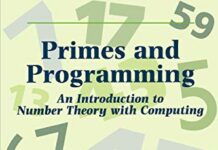
Ebook Info
- Published: 1993
- Number of pages: 252 pages
- Format: PDF
- File Size: 18.12 MB
- Authors: Peter J. Giblin
Description
Peter Giblin describes, in the context of an introduction to the theory of numbers, some of the more elementary methods for factorization and primality testing; that is, methods independent of a knowledge of other areas of mathematics. Indeed everything is developed from scratch so the mathematical prerequisites are minimal. An essential feature of the book is the large number of computer programs (written in Pascal) and a wealth of computational exercises and projects, in addition to more usual theory exercises. The theoretical development includes continued fractions and quadratic residues, directed always towards the two fundamental problems of primality testing and factorization. There is time, all the same, to include a number of topics and projects of a purely “recreational” nature.
User’s Reviews
Editorial Reviews: Review “An interesting, sophisticated introduction to number theory…” American Mathematical Monthly”Of the many volumes I have seen about `number theory and computing’, this delightful, if unorthodox, introductory text is probably the finest…a great strength of this book is its emphasis on computing and on computing examples. There are several programs included in the text, often different algorithms for achieving the same computational result, and both theoretical and practical reasons for preferring one method over another are discussed. The programming language is Pascal, which is perfectly appropriate…[and] there are a great many numerial exercises and examples…only the deadest of students could possibly consider this dry; the author has brought life and energy to the subject by his presentation.” Duncan Buell, Mathematical Reviews Book Description In this introductory book Dr Giblin describes methods that have been developed for testing the primality of numbers, provides Pascal programs for their implementation, and gives applications to coding. From the Back Cover In this book, Peter Giblin describes, in the context of an introduction to the theory of numbers, some of the more elementary methods for factorization and primality testing; that is, methods independent of a knowledge of other areas of mathematics. Indeed everything is developed from scratch so the mathematical prerequisites are minimal. Read more
Reviews from Amazon users which were colected at the time this book was published on the website:
⭐This is a book to enjoy. Learn a great deal of Number theory and almost everything about prime numbers, including topics like cryptography. The Pascal programs are clear, and will help you to learn the theory in an enjoyable way. I would expect to have a second edition implemented in Java or C++, with additional code for multiprecision arithmetic. A great book to have, if you are new to number theory. However, if you are looking for a broader coverage, the right book is “Introduction to Number Theory with computing” by RBJT Allenby and E.J. Redfern. If you do not care computing, and want to have in-depth knowledge on Number theory, “An Introduction to Number Theory” by Hardy and Wright is the best (though it is not easy-readable!). If you want to have a short but complete introduction to Number theory, get “Higher Mathematics” by Davenport.
⭐This is definitely an introduction, but since “introduction” is in the title of the book, you’ve been warned. The book is really about number theory, the programming part is very basic and much of it left to the reader/student as exercises. The programs are written in “old school” Pascal, which was the pedagogical language of choice in the pre-Internet era (I was schooled in the pre-internet era myself). This book takes little account of algorithmic efficiency (although, it does show how to get double-precision arithmetic out of Pascal). If you’re looking for an approach from scratch, this is your book. If you’re a mathematician looking for an emphasis on programming and algorithms get Hans Riesel’s “Prime Numbers and Computer Methods for Factorization” — a more advanced book. If you’re a programmer, much of the material (and sometimes more) is also in O’Reilly’s “Algorithms in…[Perl, C, C++]” in the “number theory” chapters and would make better additions to your library.
⭐I first encountered this book in Ankara, Turkey when I was working there in 1997. I’d checked it out of the British Council Library, had it photocopied (it being really inconvenient to order my own copy at that time, and in that country). Finally, 16 years later, I lost the crumbling photocopy and purchased my own legit copy of the book.Giblin’s approach to this formidable topic (my background is in physics, not pure math) is extremely concrete. Every major idea is supported by a programming exercise which allows the reader to “get his/her hands dirty”, so to speak, to actually see numerical results at every stage of the learning process. The book is dense with fascinating little asides, projects which are tangential to the main thrust of the book. I’d have to say that this book provides a path into the interesting realm of number theory that anyone with a bit of perseverance can follow.
Keywords
Free Download Primes and Programming in PDF format
Primes and Programming PDF Free Download
Download Primes and Programming 1993 PDF Free
Primes and Programming 1993 PDF Free Download
Download Primes and Programming PDF
Free Download Ebook Primes and Programming
